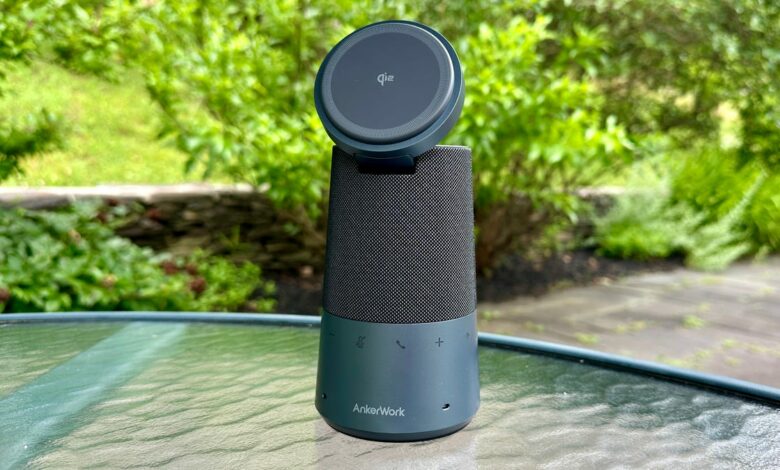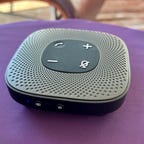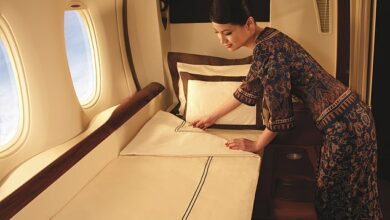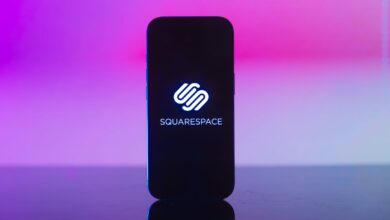Best Speakerphone in 2024 for Working From Home













Flagship Beyerdynamic speakerphone (Update: Out of stock)
Beyerdynamic Space Max

Top Bluetooth speaker that doubles as a speakerphone
Bang & Olufsen Beosound A1 2nd Gen
What’s the best overall speakerphone?
If you are a work-from-home employee, you know how challenging it can be to take calls and attempt to jot down notes while being on the call. A speakerphone can help, but it could feel like you have to shout to be heard if the quality is bad. Your meeting scenario can be improved by the use of one of the best speakerphones for working from home. This allows you to be handsfree without having anything in your ears, and you can even have multiple people involved in the call if you’re looking more for a small office setting. We’ve found a variety that are a good quality speaker so you’re sure to find one that is the right size, shape and price for your needs.
It’s hard to pick one model as the best speakerphone overall, but certain models stand out from the pack, which is why they’re at the top of this list. These include the Jabra Speak2 55 and Speak2 75, as well as the Beyerdynamic Space Max and AnkerWork S600, the most recent addition to this list. We also like the EMeet Luna Plus as a value option.
Since 2020, I’ve spent hours evaluating dozens of speakerphones, and I’ve tested all the speakerphones on this list. I review how they perform as a speakerphone and also how they sound for music listening and what connectivity options they offer (and any other noteworthy special features). All of them include some sort of wired USB connection for Windows PCs and Macs, and many also have a Bluetooth option so you can connect wirelessly. Additionally, some include UC Bluetooth dongles that are compatible with the industry standard universal communication format. That USB dongle allows for a more reliable Bluetooth connection to computers. Like UC headsets, speakerphones with a UC Bluetooth option can cost a little more.
Since premium speakerphones can get pricey, I’ve also included some best budget speakerphones for those who want to spend less than $100 (or even less than $50). Almost all the speakerphones on this list are portable and easy to take with you so you can use them at home or on the go. We also have a list of the best headsets for working from home. Some people don’t like to wear anything on or in their ears. That’s where a good speakerphone can come in handy.
Best speakerphones of 2024
The AnkerWork S600 is an interesting take on a speakerphone. While it’s not cheap at around $180, it’s basically a compact Bluetooth speaker married with a magnetic wireless charging dock that features fast Qi2 wireless charging technology. That’ll get you up to 15-watt charging for recent MagSafe-enabled iPhones and Android devices that support fast wireless charging. The speaker is equipped with four microphones and has good noise reduction — callers said my voice sounded most clear and pretty natural (not robotic). Many couldn’t tell I was on a speakerphone.
The magnetic phone stand integrates into the top of the unit and tilts up or down with a range of motion of 70 degrees. It’s good for smartphone video watching and video calls (you can put your phone in vertical or landscape mode) and there are controls on the front of the speaker for volume, answering/ending calls, a mute button and a pause/play button. While this is only a 5-watt speaker, it does have a couple of dual passive radiators that offer a reasonable amount of bass for music listening. Compared to Anker’s other speakerphones, which feature more of a flatter puck design, this model definitely sounds better for music listening and movie watching. It is a mono speaker.
You can connect it to a computer via USB-C in wired mode and there is a companion app for iOS and Android that allows you to upgrade the firmware and create a voiceprint that “enhances and highlights your voice in meetings and reduces distractions.” That’s another way of saying the speaker will better filter out background noise that isn’t your voice. The S600 is rated for up to 16 hours of battery life at moderate volume levels.
Jabra has revamped its speakerphone lineup for 2024, adding three new redesigned models that will eventually replace its earlier Speak 410, 510 and 710. The Speak2 55 is the middle model in the lineup and only slightly more expensive than the Speak2 40, which I haven’t tried yet, but it seems similar. (It’s the same size and both the Speak2 40 and Speak2 50 have 50mm drivers.) The Speak2 75 is the flagship model and offers the best sound quality and substantially better battery life in wireless Bluetooth mode — 32 hours compared to 12 for the Speak2 55. It may be overkill for some people and is also pricey.
I like how Jabra has redesigned the new models, giving them a sleek, clean look and all the models include an integrated USB-C cable with a USB-A adapter that allows you to plug the speaker directly into a Mac or Windows PC. The relatively compact Speak2 55 comes with a nice felt carrying case and is fairly lightweight, weighing 280 grams (9.88 ounces), making it easy to slip into a bag and carry around for conference calls on the go. While it offers Bluetooth 5.1 connectivity, it doesn’t come with a USB Bluetooth dongle to plug into your PC for more reliable wireless connectivity with computers.
It’s equipped with four beamforming noise-canceling microphones with background noise reduction technology (people I was conversing with said my voice sounded clear) and I thought the sound output was better than that of the Anker PowerConf S500, which retails for a little more. You can use the Speak2 55 to listen to music but don’t expect great sound quality. It’s acceptable for casual listening but there just isn’t a lot of bass. Not surprisingly, you get better sound with the larger and more expensive Speak2 75.
The Luna Plus is eMeet’s upgraded version of the original Luna speakerphone and a good value with a list price of $100, although it often sells for $80 or less with an instant coupon at Amazon. It’s designed to compete with Anker’s PowerConf (see below). It’s not quite as sleek as the PowerConf, nor does it come with a protective carrying case like that model does. Also, its microphone performance is good but not quite on the level of the Jabra Speak2 55 (see above) or Speak 510 (see below) in terms of clarity. It offers good noise reduction and is pretty compact and relatively lightweight.
The speaker does sound clear and loud — although it’s not all that good for music listening — and it’s versatile: You can go wireless over Bluetooth, plug the speaker into the USB port on your PC (with an included cable) or plug in the wireless dongle for a more reliable Bluetooth connection.
It can be daisy-chained with other eMeet speakerphones to add more people — up to 18, eMeet says — in case you’re running a business with multiple employees from home or have a really large family. Battery life is rated for 10 hours of talk time.
The Speak2 75 is Jabra’s new flagship speakerphone. It’s larger than the Speak2 55 (see above) but still portable, weighing in at 466 grams or 16.44 ounces. (It does feel more substantial than the Speak2 55.) Like the Speak2 55, this model comes with a felt carrying case and an integrated USB-C cable with a USB-A adapter for connecting the speaker directly to computers. It’s IP64 dust- and splash-proof.
The two biggest differences between this model and the Speak2 55 are the size of the drivers — 65mm versus 50mm — and the Speak2 75’s superior battery life (it’s rated for 32 hours in wireless Bluetooth mode, much more than the 12 hours you get with the Speak2 55). It also includes a Bluetooth USB dongle for more reliable wireless connectivity with computers. Alas, the USB-C version of the dongle is currently backordered, so only the USB-A version is available. That will hopefully change soon.
Jabra says the Speak2 75 has “super-wideband audio” and a microphone quality indicator that detects how well the microphones are picking up your voice. It also has four beamforming microphones with the same noise-reduction technology as the Speak2 55. Aside from the better battery life, the biggest difference I noticed was the fuller sound — it’s a bigger speaker so that’s not surprising. While it’s still not that great-sounding if you use it to play music, it does have more bass than the Speak2 55.
Callers said I sounded loud and clear with good background noise reduction. This is a top-notch speakerphone, but it is pricey.
Beyerdynamics’ Space Max speakerphone may be overkill for some people, but it’s an excellent speakerphone that’s among the best-sounding speakerphones for music listening. It has more bass than most speakerphones, and if you can afford it, you can link two together to create a stereo pair. It’s also attractively designed and feels sturdy.
This is really a small business speakerphone that can accommodate a conference call with six participants or even more using the Conference Cascade mode — it has four MEMS microphones with beamforming technology. Callers said they could hear me very clearly, and the speaker produced a clear sound with more fullness and volume than a lot of speakerphones I’ve tested. It’s also worth noting that it has a USB-C out port for charging devices and is IP64 dust- and water-resistant (splash-proof).
Significantly larger than Beyerdynamic’s original Space speakerphone (see below), it’s among the top consumer speakerphones out there.
The affordable eMeet M0 Plus is the upgraded version of eMeet’s original M0 compact USB speakerphone that connects to your computer with an included USB-C to USB-A cable. That model had no wireless option, but this one has Bluetooth 5.0, along with a plug-and-play wired option. (You have to supply your own USB-C to USB-C cable if you have a PC with USB-C connectivity.) It has a four-microphone array, acoustic echo noise cancellation, upgraded noise-reduction technology and is suitable as a conference phone for meetings with up to eight people, according to eMeet. The truth is you’d probably want a better speakerphone for that many folks.
This eMeet 10 Plus is only a 3-watt speaker, but it does sound louder and clearer than your typical laptop speakers and picks up your voice well from several feet away. It doesn’t sound great for listening to music, due to its lack of bass. You can pair two of the speakers together for larger rooms.
I liked Beyerdynamic’s earlier Phonum speakerphone (see below), which retails for about $100, but the new-for-2022 Space is a slicker product and a nice “personal” speakerphone that works well in home office environments. It also has more bass than the average speakerphone and works decently for listening to music, although it doesn’t support the higher-fidelity AAC and aptX codecs, only SBC. If you can afford it, you can wirelessly pair two of them for stereo sound.
The speaker comes in a few different color options and has touch controls on the top along with LED lights that indicate whether you’re connected via Bluetooth, on a call and whether your microphone is muted. You can also connect directly to your computer with the included USB-C cable — the speaker charges via USB-C — and a USB-C to USB-A adapter is included. You can store it in a slot in the base of the speaker, where you’ll also find a threaded tripod mount. Battery life is rated at up to 20 hours, and a 10-minute charge gives you two hours of juice. The speaker is splash-proof and dust-resistant with an IP64 rating.
Callers said I sounded clear and were generally impressed with how I sounded, saying they couldn’t tell I was on a speakerphone. Weighing 354 grams, the speakerphone is quite portable and a carrying pouch is included, while Beyerdynamic describes it as a personal speakerphone, it does have four microphones and is suitable for conference calls with up to six people sitting around it. While it’s a bit expensive at its listed price, I do suspect it will come down in price with time.
Anker’s PowerConf S3 offers solid performance for the money, with six microphones arranged in a 360-degree array to pick up the voice of up to eight people in a room. This Bluetooth speakerphone charges and connects via USB-C to your computer, if you want to go the wired route, and easily connects to your cell phone and tablet via Bluetooth technology. With an integrated 6,700 mAh battery, you can also charge your devices with the speakerphone. Battery life is rated at 24 hours for call time.
The speaker performed well, with good clarity and similar sound quality to the Jabra Speak 510. (I didn’t compare it to the newer Jabra Speak2 55.) Jabra’s Speak 710 delivers a little fuller sound with a little more bass, but that speaker costs substantially more. This can also be used as a speaker for listening to music or watching movies, but Anker says it’s first and foremost a conference speakerphone. It is a significant step up from the built-in speakers on your smartphone or laptop, particularly in terms of loudness. Whether you’re in a large conference room or a smaller conference room, it can pick up voices anywhere for up to eight people. A carrying case is included.
Note that you can’t connect more than one Bluetooth device to this conference speaker simultaneously. It’s also worth noting Anker also makes the newer PowerConf S3. I have not tried that model but it seems very similar to this one with an updated design.
The Poly Sync 20 is available with and without a Bluetooth dongle, and there’s also a Microsoft Teams-certified version. Additionally, there’s a pink version to support Breast Cancer Awareness that is currently less than $50 without the dongle.
It’s unclear if you need the dongle because the speaker has an integrated USB-A or USB-C cord to plug directly into a computer and charge the device, but the dongle makes for easier pairing.
This has everything you want in a compact but portable speaker phone. Along with the USB-A connector, it has Bluetooth. A protective carrying case and lanyard are also included. There’s also a USB out port for charging a phone. Battery life is rated at up to 20 hours.
The performance was solid. I was able to stand up to about 7 or 8 feet away from the speaker and callers said they could hear me clearly. The speaker puts out a decent amount of sound, so volume wasn’t an issue. It’s also worth noting that the touch button with the rocket icon is programmable using the Plantronics Hub app: You can choose between play-pause music, last-number redial and voice assistant as well as hold/resume call. The Microsoft Teams-certified version adds a Teams button next to the rocket button. Regardless, any model works with Teams.
I played some music through the speaker and it sounds decent although not great for a compact Bluetooth speaker. As you might expect, it’s strongest in the midrange, where vocals live, so it does well with acoustic music.
The Sync 20 Plus version with a Bluetooth dongle lists for $200 but can be had for less. Poly also has the larger Poly Sync 40 for around $200 and the line-topping Sync 60 is around $400.
The Anker PowerConf S500 is an attractively designed speakerphone that offers good performance for around $200. It’s equipped with four microphones and Anker says a single PowerConf S500 “delivers performance for rooms of up to 12 people, and you can wirelessly pair two of them to increase coverage for up to 20 people.”
You can connect your phone or computer via Bluetooth, but you can also connect the speaker directly to your computer with a USB-C cable. Additionally, it comes with a wireless Bluetooth USB dongle (it’s USB-A) for more reliable wireless connections to PCs. It’s nice that you can store the dongle in a slot on the bottom of the speakerphone when you’re not using it. I also liked the included hard carrying case.
I didn’t think this speaker performed quite as well from a sound quality standpoint as the Jabra Speak2 55 (see above), but it is a well-designed speakerphone that delivers solid performance for its price and does have better battery life than the Jabra (16 hours vs. 12 hours).
This used to be Anker’s flagship speakerphone model, but now it offers the new AnkerWork SR500 that’s equipped with eight microphones.
The best things about the Cyber Acoustics Essential Speakerphone are that it’s compact, lightweight and simple to use. Callers said they could hear me clearly, and the speaker outputs a decent amount of volume for its size. My voice didn’t sound as natural as it did with some of the more expensive models on this list.
This is a fairly basic speakerphone, but it offers Bluetooth connectivity along with a USB-wired option. It’s definitely easy to slip in a bag. While it carries a list price of $70, you can occasionally find it for less than $50 on Amazon.
Bang & Olufsen has upgraded its dome-shaped aluminum-clad A1 speaker with improved battery life, better speakerphone performance (it now has a three-microphone array) and slightly improved sound. It’s not only the smallest wireless speaker from the Danish company but also the most affordable with a list price of $230, though you can get certain colors for over $50 less. While it doesn’t have the more robust speakerphone-centric features of other products on this list, this speaker easily sounds the best for music playback.
The speaker drivers remain the same as those in the previous model, but the Qualcomm chipset that powers the speaker has been upgraded (the speaker uses Bluetooth 5.1), bumping the sound quality up a tad, particularly at higher volumes, with better digital signal processing. It remains one of the best-sounding mini Bluetooth speakers, with richer more tonally balanced sound than other Bluetooth speakers its size — and it should sound good, considering its elevated price point.
It’s also worth noting that the A1 has multipoint Bluetooth pairing so you can connect this to your PC and smartphone at the same time and easily switch back and forth between the two if a call comes in on your phone. Additionally, the speaker is Alexa-enabled, meaning you can activate Amazon’s voice assistant by just saying “Alexa.”
Battery life is rated at up to 18 hours at 50% volume (the earlier A1 didn’t live up to its battery life claims, but this number is more accurate) and if you can afford it, you can link two A1 speakers to create a stereo pair. The speaker is waterproof with an IPX67 rating that allows it to be submerged briefly in shallow water.
The Jabra Speak 510 wireless Bluetooth speaker, which has been out for a few years and is sometimes discounted to closer to $100, can be connected directly to a computer with a USB cable or wirelessly via Bluetooth. It doesn’t offer as much volume as the step-up Speak 710 Bluetooth speakerphone, which costs more than twice as much. Jabra says the speaker is suitable for smaller rooms with coverage for four people in a meeting. This portable speakerphone has a 360-degree omnidirectional microphone and its rechargeable battery will last up to 15 hours of battery life in wireless mode. A carrying case is included.
You can get this model with a UC (universal communications) USB dongle that allows you to have a direct wireless connection with a PC. The wired USB option is fine and offers the same softphone features for Windows PCs or Macs.
If you can’t afford the Jabra Speak2 75 and are looking for a compact, more “professional” Bluetooth speakerphone, the eMeet M3 costs less than $200, has a strong feature set and performed well in my tests (it plays louder than you’d think for its size). It’s equipped with a four-microphone array and acoustic echo (along with noise reduction technology) and can operate with clear sound in larger rooms with five to eight people participating in a conference call. You can opt to plug the speakerphone directly into a computer (Mac or Windows) with a USB cable or go wireless with the included Bluetooth USB dongle. You can also use Bluetooth connectivity for your smartphone or tablet. A carrying case is included and battery life is rated at up to 18 hours.
Budget
Before anything else, you’ll want to figure out how much you’re willing to spend on a new speakerphone. More premium models tend to cost $200 or more, but plenty of good options are available in the $80 to $150 range. Models that cost less than $50 are also available and do sound better than your phone’s speaker.
How do you intend to use it?
Almost all speakerphones offer the ability to plug right into your computer with a cable. Many offer wireless Bluetooth connectivity. Additionally, some models include a USB Bluetooth dongle for easy pairing and a more reliable connection with your computer.
How many people are talking?
Most of the speakerphones on this list can accommodate multiple people talking and some are suitable for larger rooms. If you’re just using it as a personal speakerphone for video conferencing or phone calls, you don’t necessarily need one of the larger, more premium models.
Portability
Take into account the size of the speakerphone if you plan on carrying it with you for mobile use.
Return policy
It’s always good to buy at a retailer that has a good return policy, in case you have buyer’s remorse. Some people who are having trouble deciding between two models sometimes buy both, try them out for a few days, and then return one.
We test speakerphones based on four key criteria. These criteria include design, performance, features and value.
- Design: Evaluating design, we assess not only how sleek the product looks but also the overall build quality and how well the controls are implemented. We also look at water- and dust-resistance ratings.
- Performance: We evaluate performance and sound quality by making several calls in a fairly large room and walking several feet away from the speakerphone. Callers let us know how we sound in both a noise-free and noisier environment (to test noise reduction). We also listen to some music through the speaker.
- Features: Some speakerphones offer additional features, such as a USB Bluetooth dongle for PC use, a charge-out port for charging devices like your cellphone and multipoint Bluetooth pairing. We test those features to make sure they work as advertised.
- Value: We weigh the product’s design, performance and features, comparing them to other speakers in the category, and determine how well the product is priced and whether it’s a good deal.
Jabra Speak 710: Jabra has released the Speak2 75, the upgraded version of its former flagship, the Speak 710. The newer model is clearly superior, but the Speak 710 is still a very good speakerphone and can be obtained at a significant discount.
Is getting a speakerphone worth it?
Are speakerphones good for music listening?
Do speakerphones have good battery life?
Should I get a headset instead of a speakerphone?












